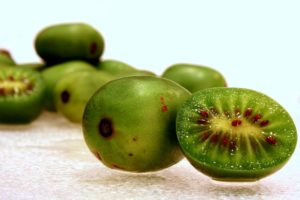Explorations of Growing the Kiwiberry in the Northeast
Kiwiberries could be the next big horticultural crop for producers in the Northeast, according to researchers. Kiwiberries are a perennial vine which produce grape-sized, smooth-skinned fruit, that look and taste like their tropical namesake. The fruit has a complex flavor profile and is easy to consume making it especially desirable in regions where they are not commonly sold. Kiwiberries combine a tropical flavor with cold hardiness making it ideal for markets in the Northeast.
Kiwiberries have a long history of being grown in the New England, first as ornamentals and more recently, in backyards for personal consumption. In the past decade these efforts have been scaled up to commercial production on a few field experiments in New England . These tests prove the viability of the kiwiberry as a field-scale horticultural product.
To further encourage production of kiwiberries in the Northeast, the New Hampshire Agricultural Experiment Station at the University of New Hampshire (UNH) has published an extensive growing guide and roadmap. The guide, developed by Iago Hale, UNH associate professor of specialty crop improvement, and UNH graduate student Will Hastings, is a culmination of over 5 years of research and observation. The plant breeding program responsible for the guide hopes that it will be a valuable resource which will allow kiwiberries to become a mainstream horticultural product in the Northeast.
“Based on their adaptation to the region, their great flavor, and their suitability for direct marketing, kiwiberries show promise as a high-value horticultural crop,” Hale said in a press release.
Besides agricultural research in commercial scale production, kiwiberries have also been consumer tested. The potential for growth in this sector is high, based on the established valuation of local produce and prevalence of direct-marketing of horticultural products. Kiwiberries are also desirable for their nutrient rich makeup and scarcity.
Read more about the kiwiberry and explore the growing guide.



In Slope Game, the only going down you’ll experience is in your score. Can you keep climbing the high score leaderboard and avoid a downhill spiral?